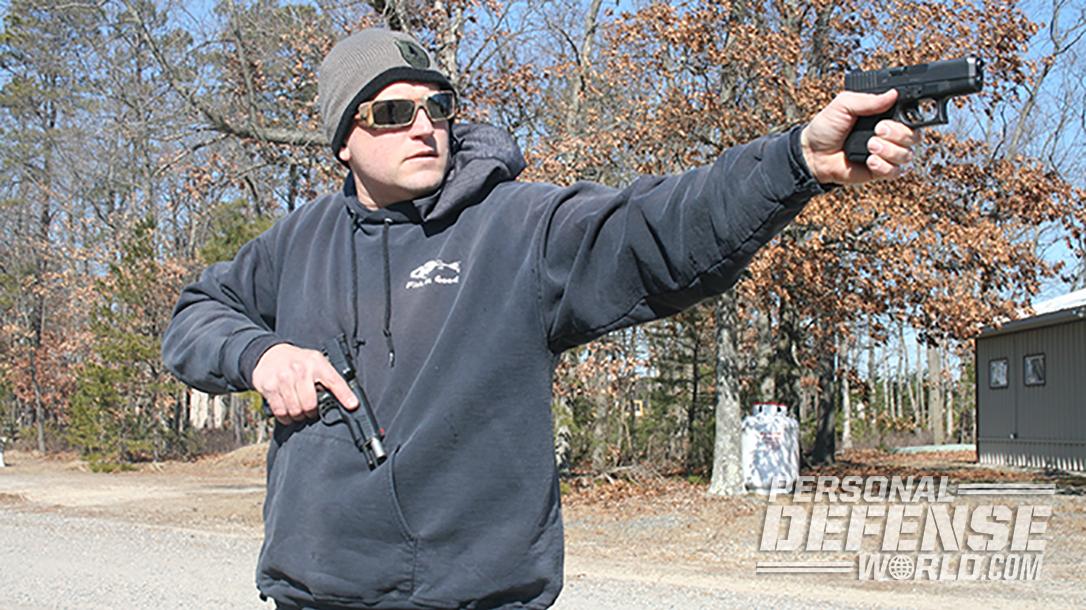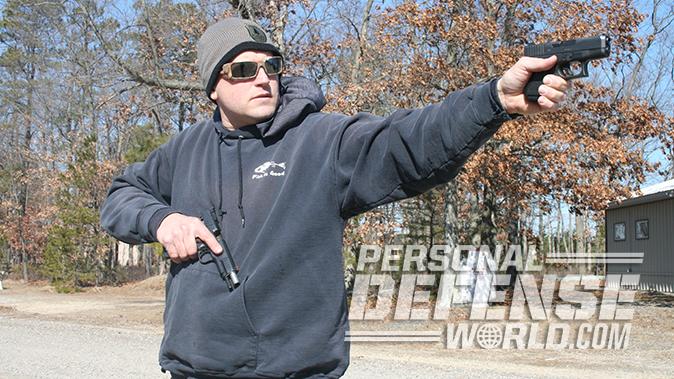The carrying of a backup gun remains a controversial topic.
I have often been the recipient of some strange looks and the occasional comment as I remain a true believer in the concept of backup weapons. “Are you expecting some trouble?” is something I’ve heard more than once over the years. My response has always been, “Not really. If I was, I’d be carrying my rifle.” That usually sends my inquisitor scurrying away.
Oddly enough, negative attitudes about backup weapons are also common in law enforcement. This is despite the fact that there have been numerous instances where an officer utilized a hidden backup to save the day. A buddy of mine, recently retired from a high-profile federal agency, was forbidden to carry a backup gun. Go figure! Like parachutes and life jackets, a backup represents your only chance of prevailing should things go bad.
Advertisement — Continue Reading Below
During my law enforcement career, I routinely carried a backup gun discreetly hidden on my person. But in retirement, does this continue to make sense? I am no longer paid to confront people, and in my current role as a responsible citizen, avoiding conflict is the order of the day. But we can’t always pick our spot.
Truth be told, old habits die hard. That same routine I followed as a law enforcement officer—carrying a primary handgun plus a backup weapon—is followed today. A little over the top you say? Let’s consider for a second a few reasons to carry a backup weapon: You need more ammo, your primary gun fails, a bad guy attempts to strip you of your primary weapon, or you need to arm another person. Think these situations can’t happen? Guess again! I’m personally familiar with real-life incidents where these very things occurred and a backup saved the day.
What Can You Carry?
Comfort remains high on our list of priorities. Given a choice of carrying heavy, cumbersome tools or light, compact ones, most everyone will opt for the latter. But, is it the best choice?
Advertisement — Continue Reading Below
Jeff Cooper is widely recognized as the father of modern pistolcraft. The good Colonel once stated, “Action in which a pistol is involved is unpredictable. There is no such thing as light duty or heavy duty in a pistol.” Truer words were never spoken. The good news today is that we no longer have to rely on heavy metal to keep us safe. One can indeed carry a lightweight yet formidable weapon or two and still blend into polite society.
First, consider your primary weapon. While we can effectively conceal a full-sized, all-steel 1911 with the right clothing and holster, most folks will probably opt for something smaller and lighter. It would be presumptuous of me to dictate what sort of handgun you should carry, but the art of compromise often weighs in. By all means, select something you can shoot to a fairly high standard when the chips are down. For me, that is a 9mm Glock 19. If my clothing or legal restrictions come into play, I might go with a Glock 26 or Kahr K9.
Advertisement — Continue Reading Below
A few years ago, I wouldn’t give you a plugged nickel for a pocket-sized autopistol to be used as a backup gun. But that has all changed now, and pistols like the Glock 43 and S&W M&P Shield excel in this role. Dinosaur that I am, I continue to rely on a S&W Airweight Bodyguard in .38 Special as my backup gun of choice.
I do have some hard and fast ideas relative to defensive handguns when it comes to caliber. The bottom of my power floor is set at 9mm and .38 Special. Even with the best ammunition, I consider the .380 ACP marginal. The bottom line is that handguns chambered for a legitimate service cartridge give you the best chance of prevailing against a determined adversary.
Carry Locations
During the cooler months, my primary handgun is worn in a belt scabbard covered by a garment. When the mercury rises, I often have to make an adjustment and go with an inside-the-waistband (IWB) rig covered by an untucked shirt.
Advertisement — Continue Reading Below
I no longer have to wear a jacket and tie or function in a business environment where clothing options are somewhat restrictive. Women will often find discreet carry options to be even more restrictive. For many of us, hiding one gun is a challenge. Stashing a second gun somewhere on the body can really be problematic.
Assuming my primary is on the belt, I typically place my backup in my support-side hip pocket. This gives me the capability of drawing and firing with the support hand if injured or struggling over my holstered primary handgun. Some folks prefer rear-pocket carry, but I for one don’t find it comfortable. To each his own.
Ankle carry is yet another viable option for a backup handgun. I’m less than enthusiastic about ankle holsters for any primary handgun, but it does have merit for a backup. On rare occasions, I have also found I could carry one gun in the pocket and another on the ankle. Better two small yet formidable guns on your person than a 1911 in the glove box.
Advertisement — Continue Reading Below
One excellent alternative for carrying a backup gun is the Holster Shirt from 5.11 Tactical. Crafted from poly/spandex, the Holster Shirt contains two pockets for carrying pistols and magazines. Worn as a T-shirt under a light covering garment, this innovation from 5.11 Tactical fills a most useful niche. The Holster Shirt comes in black and white and is available for men and women.
Another option is the iTuck from Tuff Products. The iTuck features an external cell phone compartment that is worn outside the belt and an inner compartment that can harbor a small handgun. As the name implies, the inner compartment is tucked inside the pants, effectively hiding it from view. It’s unlikely the iTuck will raise an eyebrow, and your gun is instantly accessible by lifting the outer flap.
Backup Gun Practice
Suffice it to say that shooting small guns isn’t a lot of fun. Most of us would rather spend our range time working out with our primary or fun guns. But we need to practice with all of our safety equipment. This includes all those rude snub-nose revolvers and pocket rockets we might have to protect our life with.
Advertisement — Continue Reading Below
Our practice should include drawing our backup gun from whatever type of holster we select and the type of clothing you might routinely wear. The good news is that you can practice that important drawstroke at home with an empty gun. Something else to consider is that you might have to simultaneously manage your primary weapon while drawing your backup. Quite frankly, it’s not a good idea to leave a gun on the battlefield, even if you feel that it’s inoperable.
When graduating to live fire with the backup, be sure to incorporate a lot of one-handed shooting, both with your dominant and support hands. I would also suggest that you work in some shooting from a seated position and from various grounded positions to simulate slipping or being pushed to the deck. The more realistic we can make our training, the better prepared we’ll be.
The Knife Option
Can a knife be used as an effective backup weapon? You bet! In close quarters, a knife is a very effective tool. In certain instances, a knife can be quickly brought into play when you aren’t able to draw your handgun. A retention scenario where you are struggling over your holstered weapon is one such example that comes to mind immediately. Knives are deadly. They never jam or run out of bullets and can be hidden much more easily than a handgun.
Advertisement — Continue Reading Below
Defensive knives fall into one of two categories: folders or fixed blades. Both come with their own set of advantages and disadvantages. Folding knives are far more discreet and easier to pack, but slower to get into action. A fixed blade is faster and stronger, but not especially practical for many folks. No matter your choice, make sure your knife complies with the law, as legal restrictions vary from one state to the next.
I have a preference for folders that can be opened very quickly. Two favorites from Spyderco include the P’Kal and the Karahawk, both of which incorporate the Emerson opening feature. As the knife is drawn from the pocket, the blade is instantly locked open, allowing one to quickly bring it into play.
Advertisement — Continue Reading Below
New this year is the Spyderco Introvert, which has great potential as a backup weapon. The Introvert is a folding version of the Swick neck knife. It was specifically designed for carry where fixed blades are not legal, or their use is frowned upon. Key features include a flipper opener, a sturdy back-lock mechanism and an integral finger hole that facilitates quick opening and exceptional grip security. I’m especially fond of the finger hold for retention purposes.
The Introvert has a 2.7-inch blade, with a closed length of 4 inches. The textured G-10 scales make for a positive grip, and the reversible deep pocket clip offers both left- and right-side carry. A good knife like the Introvert represents yet another ring of safety should trouble visit.
Always Armed
I’ve carried one or more weapons every day for most of my adult life. But in the end, it doesn’t matter if you carry one or 21 guns and knives if you are unprepared. Clearly, chance favors the prepared individual, and that only comes with hard work.
Getting the right gear is the easy part. But by all means, get some training on the tools you might have to use and engage in regular practice. Be aware of what is going on around you and be willing to use extreme violence to see that you prevail.
A winner’s mindset, coupled with skill and sound tactics, will go a long way in keeping you safe. The best tactic I can offer the responsible armed citizen? Don’t go to places that angels fear to tread. Unlike the police, you have a choice, and avoidance of potential conflict is the rule.
I’ll admit in retirement I don’t always carry that backup gun. But, I never leave my house without a service-caliber handgun, extra ammunition and a knife. Having that ability to go to Plan B can keep you safe when faced with seemingly insurmountable odds.
This article was originally published in “Personal & Home Defense” issue #204. To order a copy and subscribe to that magazine, visit outdoorgroupstore.com.































